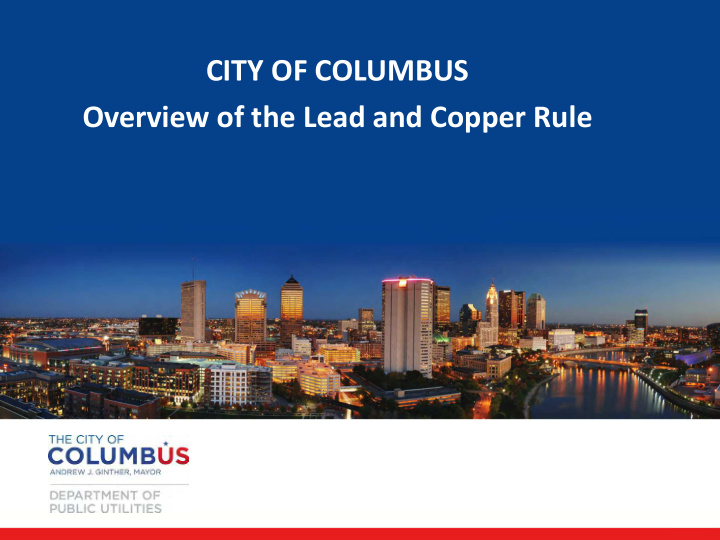



CITY OF COLUMBUS Overview of the Lead and Copper Rule
Overview of Columbus Public Water System In 2015, Columbus provided almost 49 billion gallons of safe, clean drinking • water to over 1.1 million people in 23 communities throughout the Central Ohio region Clean, safe drinking water is truly a public health business • Some quick facts about the Columbus water system infrastructure: • 3 Water Plants – 2 surface water and 1 ground water 4 Reservoirs (Hoover, O’Shaughnessy, Griggs, Doutt) 3,518 Miles of water main maintained by the City of Columbus (2,517 miles owned by Columbus; 1,001 miles owned by suburbs) 26 Booster stations operated and maintained 39 Water tanks operated storing ~81 million gallons 25,611 Fire hydrants owned by the City of Columbus Certified degreed lab analysts, certified water operators (24 hrs. per day)
Service Area 7.2 15.9 Billion Billion Gal Gal Parsons Ave. (groundwater) Dublin Rd. Hap Cremean Water Plant Hap Cremean 25.6 Dublin Rd. Billion Water Plant City of Columbus Gal 48.7 billion gallons in 2015 • 85% surface water • Parsons Ave. Service population 1.16 • Water Plant million (groundwater)
Our Water Plants Dublin Road Water Plant Hap Cremean Water Plant Parsons Avenue Water Plant
Columbus Is In Compliance With All Of The Safe Drinking Water Act Requirements …Including the Lead and Copper Rule Lead (micrograms per liter) Copper (micrograms per liter) Year 90 th Percentile 90 th Percentile 2014 <1.0 58.7 2011 <1.0 51.0 2008 <1.0 69.4 2005 <1.0 53.7 The Regulatory Lead Action Level is 15 ug/L and the Copper Action Level is 1300 ug/L A microgram per liter (ug/L) is equivalent to 1 second in 37.1 years
Environmental Sources of Lead Lead paint and lead dust (most significant source of lead) (CDC, CDPH) • Imported medicines and makeup (CDC) • Imported dishes and containers (CDC) • Imported candy and toys (CDC) • Hobbies like arts, crafts, imported clay pots, imported jewelry (CDC) • Hunting (Regulations now require stainless shot) and fishing (CDC) • Lead service lines and home plumbing • – From a water system without optimum corrosion control
Where Can Lead In Water Come From? The water leaving Columbus water plants doesn’t have any lead • Lead is found: • – Lead based solder in home plumbing (lead solder banned in 1986) – Brass fixtures (brass contained up to 8% lead until 2014) • New rules were adopted in 2014 for lead free plumbing (<0.2% lead) – Customer’s service pipes if lead – City owned service lines (~10% of city water service pipes are lead) (Columbus spends approximately $20 million annually to replace water mains with frequent main breaks as part of its repair and replacement program. All existing water services (lead, copper, etc.) are replaced with the water main). Also, during the repair of water main breaks, if lead services are encountered, they are replaced with copper.
Columbus Has an Optimal Water Corrosion Control Program Treatment • – Neutral pH adjustment to 7.8, not acidic or basic – Add corrosion inhibitor – zinc orthophosphate $1800 per day Required Monitoring and Testing • – Test water plant tap every other week for required water quality parameters • Hardness, alkalinity, pH, corrosion inhibitor – 50 customer homes every 3 years (25 lead services, 25 built 1982-1986) (First draw) – Distribution system water quality quarterly during the same year of 50 homes Additional Monitoring and Testing • – Test plant tap water multiple times per day for many water quality parameters – Test distribution system samples monthly for water quality parameters – Test representative distribution system samples monthly for lead – Lead (and other metals) coupon testing
Zinc Orthophosphate Feed
Division of Water’s Corrosion Control Program (Continued) Required Public Education • – Mail results to the 50 customers who participated in sample collection – Publish results in the annual consumer confidence report (mailed annually to all customers, also available at Columbus.gov/utilities under document library). Additional Public Education • – Annual brochure “What you need to know about lead in Drinking Water” – DPU website has a lead brochure (also mailed annually) Studies • – Study of over 2000 homes in year 2000 where we tested directly from the lead service line – Lead profiles of homes and other studies – Cooperative project with Columbus Public Health’s Healthy Homes Program
Other Water Systems Who Receive Our Water And Test For Lead? • All are in compliance with the Lead and Copper Rule Reynoldsburg – 2014 • – 30 homes every 3 years Bexley – 2014 • – 30 homes every 3 years Franklin County – 2014 • – 20 homes every 3 years Gahanna – 2015 • – 30 homes every 3 years Lockbourne – 2015 • – 5 homes every 3 years
What Can Customers Do To Reduce Their Risk? Check home plumbing for any sources of lead • If their home was built before 1950’s • – Call the Division of Water to identify the service line material If they have lead or think they have lead: • – Flush the tap for 30 seconds or longer if water has sat unused for more than six hours – Cook with cold water For specific questions about lead call: • – Columbus Water Quality Assurance Lab (614) 645-7691 – See “Lead in Water” and “Consumer Confidence Report” at Columbus.gov/utilities under document library
Summary Columbus provides drinking water meeting or exceeding drinking water • regulations. Columbus goes beyond minimum requirements to provide safe drinking water. Columbus has an excellent corrosion control program based on monitoring, • research, and treatment of reliable water resources. Columbus has a history of transparency and communications regarding its • drinking water as exemplified by the annual CCR, lead brochure, and lead program. Columbus has strong leadership all the way from our elected officials to • our rate payers, who provide the resources and support to effectively treat drinking water.
Recommend
More recommend